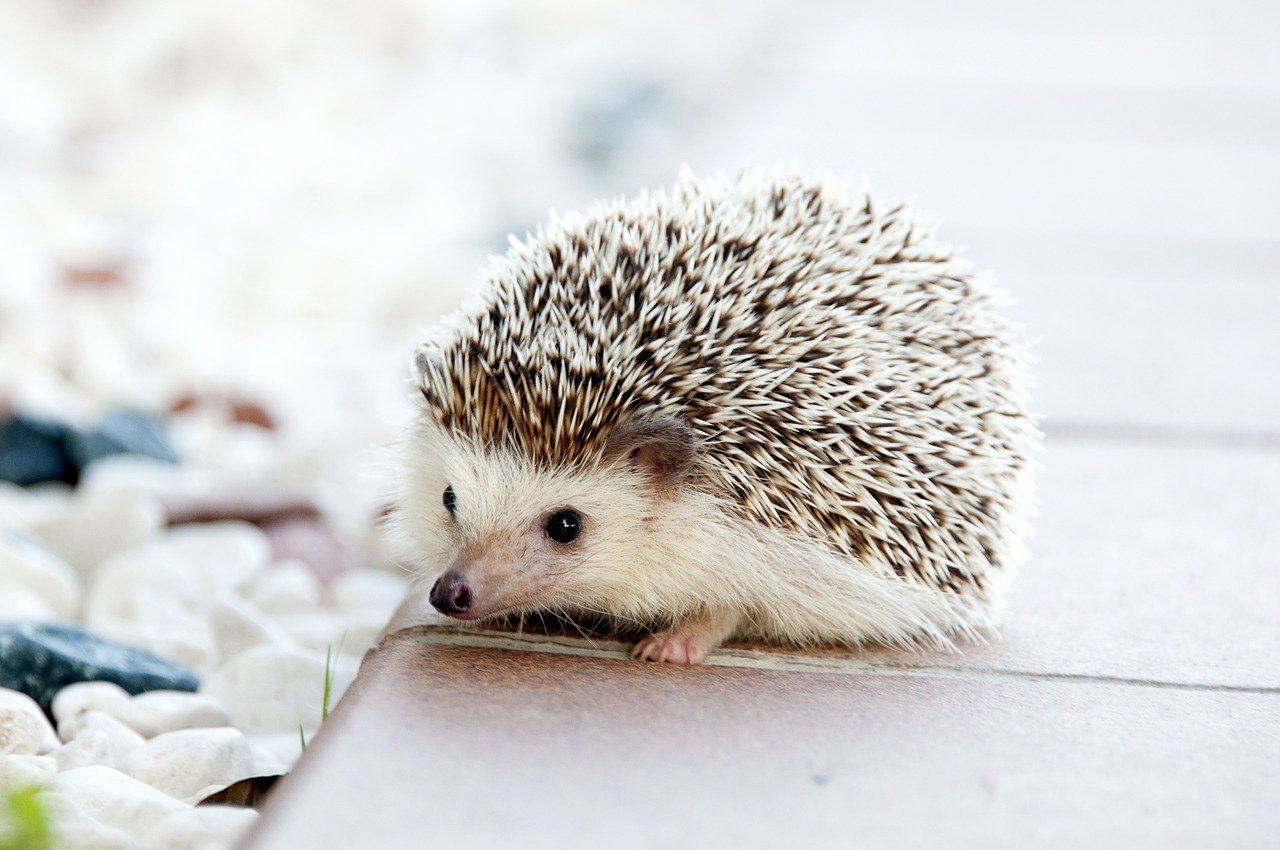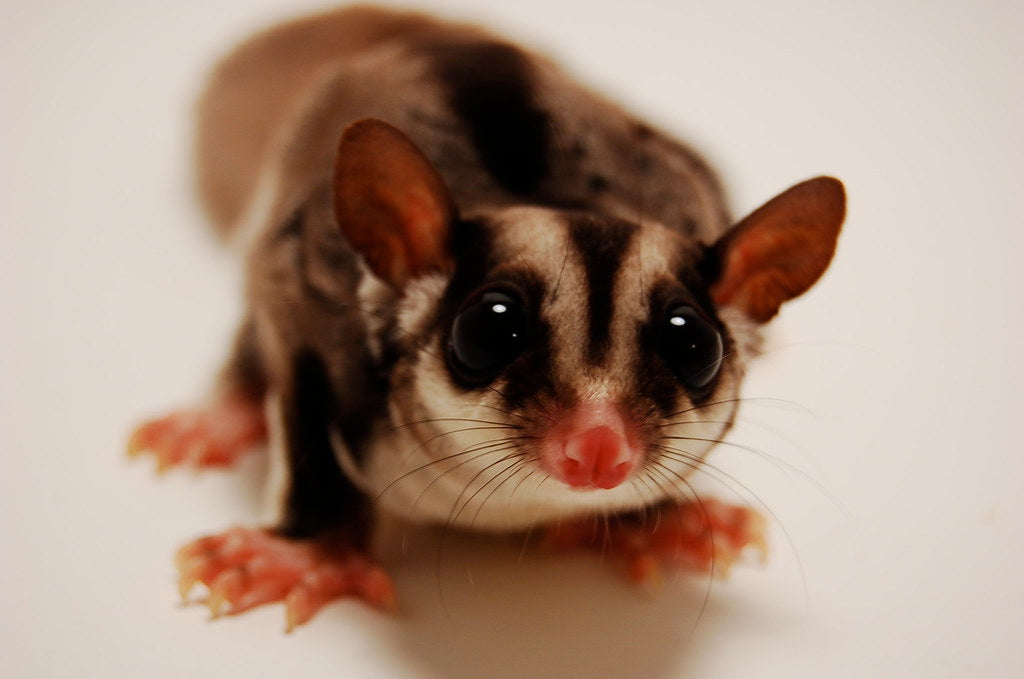Hedgehogs are a group of small, terrestrial, nocturnal exotic mammals that can be found in parts of Europe, Asia, and Africa. They are also invasive in New Zealand. Hedgehogs can be found in a variety of habitats, including savanna, forest, desert, scrubland, and even suburban areas, depending on species. However, the most common hedgehogs in captivity are the four-toed hedgehog hedgehog (Atelerix albivetris), the long-eared hedgehog (Hemiechinus auritus), and the Indian long-eared hedgehog (Hemiechinus collaris). Hybrids between A. albiventris and A. algirus (known as the African pygmy hedgehog) are also popular.
Hedgehogs’ specific appearance varies based on species, but generally speaking, they are around 6-8” long, with long, pointed snouts; small, dark eyes; short legs; small feet; and of course, plentiful short spines covering the majority of their body. They are well known for their ability to curl into a spiny ball when threatened. Hedgehogs are usually cream, tan, brown, black, and/or gray in color, although other colors and patterns have become available through captive breeding.
Hedgehogs are popular pets, but because of their similarity in appearance to more common pet rats, gerbils, hamsters, etc. It’s important to remember that despite the fact they are mammals, they are still exotic pets with special care needs. In fact, they are actually illegal to own in some states, so check your local laws before you dive too deep into hedgehog care research. With good care, these pets can live up to 8-10 years.
How much space do hedgehogs need?
Hedgehogs are quite active, which means that they need plenty of space to move around. The minimum enclosure size is 4’L x 2’W (8 sq ft of space), but larger is appreciated and definitely will be used. Although hedgehogs are fairly poor climbers, the sides of the enclosure should be tall and smooth enough to prevent potential escape.
Cohabitation (keeping multiple hedgehogs in one enclosure) is not recommended
Do hedgehogs need UVB?
Hedgehogs are nocturnal, and are definitely able to survive without it. However, providing artificial UVB lighting to simulate daylight may still provide subtle benefits to your pet’s long-term health. UVB lighting helps regulate circadian rhythm, gives them all of the vitamin D that their body needs, stimulates better appetite and activity, and generally allows them to be healthier than they would be without.
The best UVB bulbs for hedgehogs are:
- Zoo Med T8 Reptisun 5.0
- Arcadia ShadeDweller
The UVB bulb should be housed in a reflective fixture and placed on one side of the enclosure, about 8-13” above the hedgehog’s back. UVB is blocked by glass and plastic, so you can’t give your pet UVB by placing its enclosure in front of an open window. Also make sure that the fixture your UVB bulb is in does not have a clear plastic bulb cover. UVB bulbs decay over time, so don’t forget to replace your bulb every 12 months to maintain good performance.
If you don’t want to set up UVB lighting for your hedgehog, make sure to provide some kind of daytime lighting, or place the enclosure in a well-lit room. Lights should be on for 12 hours/day to simulate daylight.
What temperatures do hedgehogs need?
Although hedgehogs are endotherms like other mammals, they still generally prefer warmer temperatures than humans usually find comfortable.
Your hedgehog’s enclosure should be maintained between 75-80°F to keep your pet happy and active. Temperatures outside of this range can cause grumpiness and induce hibernation or torpor. Make sure to measure your temperatures with digital probe thermometers placed on the warm and cool sides of the enclosure.
A good way to warm your hedgehog’s enclosure is with a heat mat placed under half of the enclosure, or ceramic heat emitters. These devices should be plugged into a thermostat to prevent them from getting too hot.
What humidity levels do hedgehogs need?
Hedgehogs aren’t terribly demanding when it comes to humidity, but air humidity below 30% will make them uncomfortable and itchy because it dries out their skin. The best way to remedy this is by installing a humidifier in the hedgehog’s room. You’ll probably end up more comfortable, too!
What bedding is good for hedgehogs?
Providing bedding for your hedgehog helps cushion their body and gives them something to burrow around in. We recommend the following substrates for hedgehogs:
- aspen shavings
- shredded paper
- Carefresh
- fleece
Substrate should be at least 3” deep and replaced or washed once a week. Clean the enclosure with odorless products, as hedgehogs have very sensitive noses!
In some cases, hedgehogs can be trained to use a litterbox in one corner of their enclosure.
What décor can you use in a hedgehog enclosure?
It’s terribly boring for a hedgehog to be stuck in an enclosure with nothing in it except bedding and food/water bowls. It doesn’t matter how big the enclosure is if you don’t put things in it for your pet to use and interact with!
Here are some ideas:
- 11-12” exercise wheel (no wire!)
- hiding places
- tubing/tunnels
- pipes
- ramps
- ledges
Balls, bells, chew toys, and other small animal toys also make good additions for entertainment.
What do hedgehogs eat?
Hedgehogs are omnivores, which means that they need both plant and animal matter in their diet in order to get the nutrition that they need. Their diet should be high in protein (>30%) and low in fat (<10%). Adult hedgehogs should get about ¼ cup of food daily.
Main diet options for hedgehogs:
- dry/wet cat food (no fish flavors)
- commercial hedgehog diet
Fruits and vegetables, as well as insects, can be offered as treats and to add variety to your pet’s diet. Here are some options to consider:
- crickets
- roaches
- black soldier fly larvae
- mealworms
- waxworms
- boiled egg
- peas
- broccoli
- corn
- carrot
- apple
- berries
Water
Make sure to keep a small, shallow water bowl or water bottle available at all times. Check with the hedgehog’s breeder first to make sure your hedgehog is water bottle-trained. Keep the water clean at all times, and scrub with animal-safe disinfectant once a week.
Do hedgehogs like to be handled?
Hedgehogs can be a bit antisocial at first, but with patience, they will get used to you and eventually become quite tame. Here are some rules to keep in mind:
- Wait at least 2 weeks before attempting to handle your new hedgehog.
- Handle in the evening or at night, when your hedgehog is naturally active.
- Never move quickly or otherwise startle your hedgehog.
- Wash your hands first so your fingers don’t smell potentially like food.
- If the hedgehog bites, don’t put it back immediately — this actually encourages biting behavior.
Hand-feeding with soft-tipped feeding tongs can be a great way to bond with your pet!
*This care sheet contains only very basic information. Although it’s a good introduction, please do further research with high-quality sources to obtain additional information on caring for this species.
Image by Amaya Eguizábal from Pixabay



Leave a comment
This site is protected by hCaptcha and the hCaptcha Privacy Policy and Terms of Service apply.